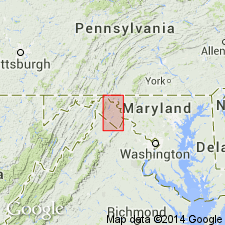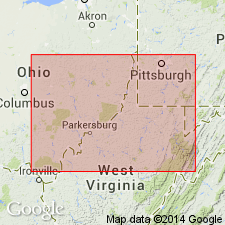
- Usage in publication:
-
- St. Paul group*
- Modifications:
-
- Named
- Dominant lithology:
-
- Limestone
- AAPG geologic province:
-
- Appalachian basin
Summary:
Named the St. Paul group for St. Paul's Church, 9 miles south of Hagerstown, Washington Co., MD. The group consists of the (ascending) Row Park limestone and New Market limestone. Name is proposed as a substitute for Stones River group in MD, PA, and WV. Group overlies the Beekmantown group and underlies the Chambersburg limestone, or by the Lincolnshire limestone where it is present. Thickness is 485 feet at the type section. The Row Park is recognized only as far south as Bessemer, WV. The St. Paul group is of Middle Ordovician age.
Source: GNU records (USGS DDS-6; Reston GNULEX).

- Usage in publication:
-
- St. Paul Group
- Modifications:
-
- Overview
- AAPG geologic province:
-
- Appalachian basin
Summary:
In Washington Co., MD, the St. Paul Group is divided into the (ascending) Row Park Limestone and New Market Limestone. The Row Park consists of light gray, fine-grained, medium- to thick-bedded limestone and dolomitic limestone with interbedded dark gray, cherty, granular limestone whose thickness ranges from 100 feet in southern area to 680 in northern area; the New Market consists of light gray, thin-bedded, laminated argillaceous limestone in the lower part and gray, thick-bedded fossiliferous limestone in the upper part whose thickness ranges from 280 feet in the southern area to 700 feet in the northern area. The St. Paul Group overlies the Pinesburg Station Dolomite of the Beekmantown Group and underlies the Chambersburg Limestone.
Source: GNU records (USGS DDS-6; Reston GNULEX).

- Usage in publication:
-
- St. Paul Group*
- Modifications:
-
- Overview
- AAPG geologic province:
-
- Appalachian basin
Summary:
In cross section E-E', in the subsurface of central West Virginia and west-central Virginia, St. Paul Group is used for greenish-gray to grayish-green, fine-grained, micritic limestone. Following the usage of Wagner (1966), includes the New Market Limestone in Virginia and West Virginia, the Row Park Limestone in West Virginia, and a correlative, unnamed, argillaceous limestone unit in the Rome trough and the Ohio-West Virginia hinge zone. In Ohio, this unit is replaced by the Black River Limestone, a usage favored by the Ohio Division of Geological Survey. Age is Middle Ordovician (late Chazyan through early Blackriveran) based on diverse faunas from St. Paul Group in Maryland and adjoining areas.
Source: GNU records (USGS DDS-6; Reston GNULEX).
For more information, please contact Nancy Stamm, Geologic Names Committee Secretary.
Asterisk (*) indicates published by U.S. Geological Survey authors.
"No current usage" (†) implies that a name has been abandoned or has fallen into disuse. Former usage and, if known, replacement name given in parentheses ( ).
Slash (/) indicates name conflicts with nomenclatural guidelines (CSN, 1933; ACSN, 1961, 1970; NACSN, 1983, 2005, 2021). May be explained within brackets ([ ]).

